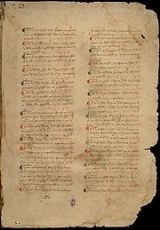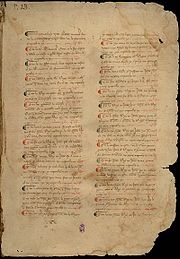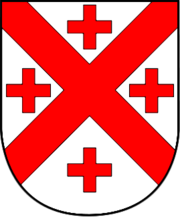
Catalan Company
Encyclopedia

Mercenary
A mercenary, is a person who takes part in an armed conflict based on the promise of material compensation rather than having a direct interest in, or a legal obligation to, the conflict itself. A non-conscript professional member of a regular army is not considered to be a mercenary although he...
founded by Roger de Flor
Roger de Flor
Roger de Flor , also known as Ruggero/Ruggiero da Fiore or Rutger von Blum or Ruggero Flores, was a military adventurer active in Sicily, Italy and the Byzantine Empire...
in the early 14th-century. De Flor recruited soldiers left unemployed with the Peace of Caltabellotta
Peace of Caltabellotta
The Peace of Caltabellotta, signed on 31 August, 1302, was the last of a series of treaties, including those of Tarascon and Anagni, designed to end the conflict between the Houses of Anjou and Barcelona for ascendancy in the Mediterranean and especially Sicily and the Mezzogiorno.The peace divided...
in 1302 by the Crown of Aragon
Crown of Aragon
The Crown of Aragon Corona d'Aragón Corona d'Aragó Corona Aragonum controlling a large portion of the present-day eastern Spain and southeastern France, as well as some of the major islands and mainland possessions stretching across the Mediterranean as far as Greece...
who opposed the French
France
The French Republic , The French Republic , The French Republic , (commonly known as France , is a unitary semi-presidential republic in Western Europe with several overseas territories and islands located on other continents and in the Indian, Pacific, and Atlantic oceans. Metropolitan France...
dynasty of Anjou
Anjou
Anjou is a former county , duchy and province centred on the city of Angers in the lower Loire Valley of western France. It corresponds largely to the present-day département of Maine-et-Loire...
.
In 1303 de Flor offered the services of his Company to the Byzantine emperor Andronicus II Palaeologus and his son the Basileus Michael IX Palaeologus. The Byzantine Empire
Byzantine Empire
The Byzantine Empire was the Eastern Roman Empire during the periods of Late Antiquity and the Middle Ages, centred on the capital of Constantinople. Known simply as the Roman Empire or Romania to its inhabitants and neighbours, the Empire was the direct continuation of the Ancient Roman State...
was under threat by the Turks
Turkic peoples
The Turkic peoples are peoples residing in northern, central and western Asia, southern Siberia and northwestern China and parts of eastern Europe. They speak languages belonging to the Turkic language family. They share, to varying degrees, certain cultural traits and historical backgrounds...
who were invading Anatolia
Anatolia
Anatolia is a geographic and historical term denoting the westernmost protrusion of Asia, comprising the majority of the Republic of Turkey...
.
Roger de Flor's offer was accepted by both Byzantium and by the Aragonese
Crown of Aragon
The Crown of Aragon Corona d'Aragón Corona d'Aragó Corona Aragonum controlling a large portion of the present-day eastern Spain and southeastern France, as well as some of the major islands and mainland possessions stretching across the Mediterranean as far as Greece...
, rulers in Sicily and southern Italy
Italy
Italy , officially the Italian Republic languages]] under the European Charter for Regional or Minority Languages. In each of these, Italy's official name is as follows:;;;;;;;;), is a unitary parliamentary republic in South-Central Europe. To the north it borders France, Switzerland, Austria and...
, who were quite eager to rid themselves of unemployed and unruly soldiers. Roger de Flor departed with 39 galleys and transports
Horse transports in the Middle Ages
Horse transports in the Middle Ages were boats used for effective means of transporting horses over long distances, whether for war or general transport...
carrying around 1,500 knights and 4,000 Almogavars
Almogavars
The almogavars were a class of soldiers from the Crown of Aragon, well-known during the Christian Reconquista of the Iberian Peninsula. They were much employed as mercenaries in Italy, Latin Greece and the Levant during the 13th and 14th centuries.-History:The Almogavars came mainly from the...
, special foot soldiers employed mainly serving the kingdom interests in the Mediterranean Sea, especially by the Crown of Aragon.
Roger de Flor arrived in Constantinople
Constantinople
Constantinople was the capital of the Roman, Eastern Roman, Byzantine, Latin, and Ottoman Empires. Throughout most of the Middle Ages, Constantinople was Europe's largest and wealthiest city.-Names:...
(modern Istanbul
Istanbul
Istanbul , historically known as Byzantium and Constantinople , is the largest city of Turkey. Istanbul metropolitan province had 13.26 million people living in it as of December, 2010, which is 18% of Turkey's population and the 3rd largest metropolitan area in Europe after London and...
) with the help of king Frederick III of Sicily
Frederick III of Sicily
Frederick II was the regent and subsequently King of Sicily from 1295 until his death. He was the third son of Peter III of Aragon and served in the War of the Sicilian Vespers on behalf of his father and brothers, Alfonso and James...
in 1303, and married the niece of Andronicus, daughter of the Tsar
Tsar
Tsar is a title used to designate certain European Slavic monarchs or supreme rulers. As a system of government in the Tsardom of Russia and Russian Empire, it is known as Tsarist autocracy, or Tsarism...
of Bulgaria
Bulgaria
Bulgaria , officially the Republic of Bulgaria , is a parliamentary democracy within a unitary constitutional republic in Southeast Europe. The country borders Romania to the north, Serbia and Macedonia to the west, Greece and Turkey to the south, as well as the Black Sea to the east...
, and was named Grand Duke
Megas Doux
The megas doux was one of the highest positions in the hierarchy of the later Byzantine Empire, denoting the commander-in-chief of the Byzantine navy. It is sometimes also given by the half-Latinizations megaduke or megadux...
(head of the fleet). Roger de Flor campaigned with his Company in Anatolia
Anatolia
Anatolia is a geographic and historical term denoting the westernmost protrusion of Asia, comprising the majority of the Republic of Turkey...
and defeating the Turks
Turkish people
Turkish people, also known as the "Turks" , are an ethnic group primarily living in Turkey and in the former lands of the Ottoman Empire where Turkish minorities had been established in Bulgaria, Cyprus, Bosnia and Herzegovina, Georgia, Greece, Kosovo, Macedonia, and Romania...
but also engaging in widespread violence and looting of the Byzantine inhabitants. By this point, the Catalans, who had recruited nearly 3000 Turkic horse into their ranks, were considered by the Byzantines to be little better than brigands and freebooters. The successes had inflated the already arrogant De Flor, leading him to entertain plans of establishing his own dominion in Anatolia.
This put him at odds with the Byzantine Emperor, and the indiscipline of the Almogavars marked the end of Roger de Flor. On 30 April 1305, he was slain along with 300 cavalry and 1,000 infantry by the Alans
Alans
The Alans, or the Alani, occasionally termed Alauni or Halani, were a group of Sarmatian tribes, nomadic pastoralists of the 1st millennium AD who spoke an Eastern Iranian language which derived from Scytho-Sarmatian and which in turn evolved into modern Ossetian.-Name:The various forms of Alan —...
, another group of mercenaries at the service of the Emperor. Roger had been in Adrianopolis (modern Edirne
Edirne
Edirne is a city in Eastern Thrace, the northwestern part of Turkey, close to the borders with Greece and Bulgaria. Edirne served as the capital city of the Ottoman Empire from 1365 to 1453, before Constantinople became the empire's new capital. At present, Edirne is the capital of the Edirne...
) attending a banquet offered by Emperor Michael. The emperor later attacked Gallipoli
Gallipoli
The Gallipoli peninsula is located in Turkish Thrace , the European part of Turkey, with the Aegean Sea to the west and the Dardanelles straits to the east. Gallipoli derives its name from the Greek "Καλλίπολις" , meaning "Beautiful City"...
attempting to conquer the city from the remnants of the Company under the command of Berenguer de Entença who had arrived with 9 Catalan galleys. The attack was unsuccessful, but it largely decimated the Company. Berenguer de Entença was captured by the Genoese
Genoa
Genoa |Ligurian]] Zena ; Latin and, archaically, English Genua) is a city and an important seaport in northern Italy, the capital of the Province of Genoa and of the region of Liguria....
shortly after, and later liberated. The Company had only 206 horsemen, 1,256 foot soldiers left and no clear leader when Emperor Michael, trusting in his numerical superiority attacked, only to be defeated in Apros in July 1305.
In 1305, Catalan leader Bernat de Rocafort formed an alliance with Theodore Svetoslav of Bulgaria
Theodore Svetoslav of Bulgaria
Theodore Svetoslav ruled as emperor of Bulgaria from 1300 to 1322. The date of his birth is unknown. He was a wise and capable ruler who brought stability and relative prosperity to the Bulgarian Empire after two decades of constant Mongol intervention in the internal issues of the Empire...
. De Rocafort married the Bulgarian tsar's sister and several joint Bulgarian–Catalan raids of Byzantine-ruled Thrace were organized as a result. The Company proceeded to devastate the regions of Thrace
Thrace
Thrace is a historical and geographic area in southeast Europe. As a geographical concept, Thrace designates a region bounded by the Balkan Mountains on the north, Rhodope Mountains and the Aegean Sea on the south, and by the Black Sea and the Sea of Marmara on the east...
and Macedonia
Macedonia (region)
Macedonia is a geographical and historical region of the Balkan peninsula in southeastern Europe. Its boundaries have changed considerably over time, but nowadays the region is considered to include parts of five Balkan countries: Greece, the Republic of Macedonia, Bulgaria, Albania, Serbia, as...
for the next two years, including an attack on Mount Athos
Mount Athos
Mount Athos is a mountain and peninsula in Macedonia, Greece. A World Heritage Site, it is home to 20 Eastern Orthodox monasteries and forms a self-governed monastic state within the sovereignty of the Hellenic Republic. Spiritually, Mount Athos comes under the direct jurisdiction of the...
. Until recently no Catalans were allowed on the Athos peninsula by the Athonite monks. However in the past few years and following the payment of reparations by the Catalan government this situation has changed.

Frederick III of Sicily
Frederick II was the regent and subsequently King of Sicily from 1295 until his death. He was the third son of Peter III of Aragon and served in the War of the Sicilian Vespers on behalf of his father and brothers, Alfonso and James...
tried to gain control over it. He assigned the Infante Ferdinand of Majorca
Ferdinand of Majorca
Ferdinand of Majorca , Infante of Majorca, was the third son of James II of Majorca, Viscount of Aumelas and Lord of Frontignan....
to Gallipoli to become its Captain. However one of the leaders of the Company, Bernat de Rocafort opposed this move, and faced Berenguer de Entença, Ferran Ximenis d'Arenós, and others who had accepted the Infante. The struggle ended with the departure of both the Infante and Ferran, and with Bernat de Rocafort becoming leader of the Company.
The administrator, Ramon Muntaner
Ramon Muntaner
Ramon Muntaner was a Catalan soldier and writer who wrote the Crònica, a chronicle of his life, including his adventures as a commander in the Catalan Company...
also left and later wrote a chronicle about exploits of the Company.
Bernat de Rocafort offered the Company's services to Charles of Valois
Charles of Valois
Charles of Valois was the fourth son of Philip III of France and Isabella of Aragon. His mother was a daughter of James I of Aragon and Yolande of Hungary. He was a member of the House of Capet and founded the House of Valois...
to strengthen his claim to the Byzantine Empire and whom the Count of Barcelona
House of Barcelona
The House of Barcelona was a medieval dynasty that ruled the County of Barcelona continuously from 878 and the Crown of Aragon from 1137 . From the male part they descend from the Bellonids, the descendants of Wifred the Hairy...
had expelled from Sicily before founding the Company in a dynastic war for the Crown of Aragon
Crown of Aragon
The Crown of Aragon Corona d'Aragón Corona d'Aragó Corona Aragonum controlling a large portion of the present-day eastern Spain and southeastern France, as well as some of the major islands and mainland possessions stretching across the Mediterranean as far as Greece...
. In 1309, Thibault de Chepoy, the deputy of Charles of Valois, ended the leadership of Rocafort, arresting him and sending him to Naples
Naples
Naples is a city in Southern Italy, situated on the country's west coast by the Gulf of Naples. Lying between two notable volcanic regions, Mount Vesuvius and the Phlegraean Fields, it is the capital of the region of Campania and of the province of Naples...
where he died of hunger the same year.
In 1310 Roger Deslaur
Roger Deslaur
Roger Deslaur or Desllor, an almogàver from Roussillon in the service of Walter V of Brienne, Duke of Athens, was one of the few knights to survive the bloody Battle of Halmyros on 15 March 1311...
then offered its service to Walter V of Brienne
Walter V of Brienne
Gautier or Walter V of Brienne was born in Brienne-le-Château, Aube, Champagne, France. He was the son of Hugh de Candie des Brienne, known as Hugh of Brienne, Count of Brienne and Lecce, and Isabella de la Roche, daughter of Guy I of la Roche, Duke of Athens...
Duke of Athens
Duchy of Athens
The Duchy of Athens was one of the Crusader States set up in Greece after the conquest of the Byzantine Empire during the Fourth Crusade, encompassing the regions of Attica and Boeotia, and surviving until its conquest by the Ottoman Empire in the 15th century....
and within a year it freed the duchy of its enemies, only to be betrayed by Brienne who refused to pay for is services. The Company avenged itself, defeating and killing Brienne in the Battle of Halmyros
Battle of Halmyros
The Battle of Halmyros, of Orchomenos, or of the Cephissus was fought on 15 March 1311 between the Frankish Greek forces of Walter V of Brienne and the mercenaries of the Catalan Company, resulting in a devastating victory for the Catalans....
on the March 15, 1311, taking control of the duchy of Athens. Around this time, the Company also conquered the city of Thebes.
No longer under control of the French the new Aragonese
Crown of Aragon
The Crown of Aragon Corona d'Aragón Corona d'Aragó Corona Aragonum controlling a large portion of the present-day eastern Spain and southeastern France, as well as some of the major islands and mainland possessions stretching across the Mediterranean as far as Greece...
lands expanded into Thessaly
Thessaly
Thessaly is a traditional geographical region and an administrative region of Greece, comprising most of the ancient region of the same name. Before the Greek Dark Ages, Thessaly was known as Aeolia, and appears thus in Homer's Odyssey....
and became the duchies of Athens and Neopatria
Duchy of Neopatria
The Duchy of Neopatria or Neopatras was one of the Crusader States set up in Greece after the conquest of the Byzantine Empire during the Fourth Crusade...
.
The Catalan rule was to last uninterruptedly until 1388–1390 when they were defeated by the Navarrese Company
Navarrese Company
The Navarrese Company was a company of mercenaries, mostly from Navarre and Gascony, which fought in Greece during the late 14th century and early 15th century, in the twilight of Frankish power in the dwindling remnant of the Latin Empire...
under Pedro de San Superano, Juan de Urtubia
Juan de Urtubia
Juan de Urtubia was a Navarrese royal squire who led first a contingent of fifty men-at-arms on an expedition...
, and allied with the Florentines
Florence
Florence is the capital city of the Italian region of Tuscany and of the province of Florence. It is the most populous city in Tuscany, with approximately 370,000 inhabitants, expanding to over 1.5 million in the metropolitan area....
under Nerio I Acciaioli
Nerio I Acciaioli
Nerio I Acciaioli was as Italian aristocrat from Florence who rose to power in Frankish Greece during the last decades of the fourteenth century, eventually becoming Duke of Athens....
of Corinth
Corinth
Corinth is a city and former municipality in Corinthia, Peloponnese, Greece. Since the 2011 local government reform it is part of the municipality Corinth, of which it is the seat and a municipal unit...
. His descendants controlled them until 1456 when they were conquered by the Ottoman Empire
Ottoman Empire
The Ottoman EmpireIt was usually referred to as the "Ottoman Empire", the "Turkish Empire", the "Ottoman Caliphate" or more commonly "Turkey" by its contemporaries...
. By that time, like many military enterprises, the Great Company had faded out of history.
Sources and references
- Setton, Kenneth M.Kenneth SettonKenneth Meyer Setton was an American historian and an expert on the history of medieval Europe.- Early life, education and awards :...
(general editor) A History of the Crusades: Volume III — The Fourteenth and Fifteenth Centuries. Harry W. Hazard, editor. University of Wisconsin Press: Madison, 1975. - Setton, Kenneth M. Catalan Domination of Athens 1311–1380. Revised edition. Variorum: London, 1975.
- Catalan Company (1302-1388 AD), by David Kuijt and Chris Brantley
- History (14th century). Aragon

